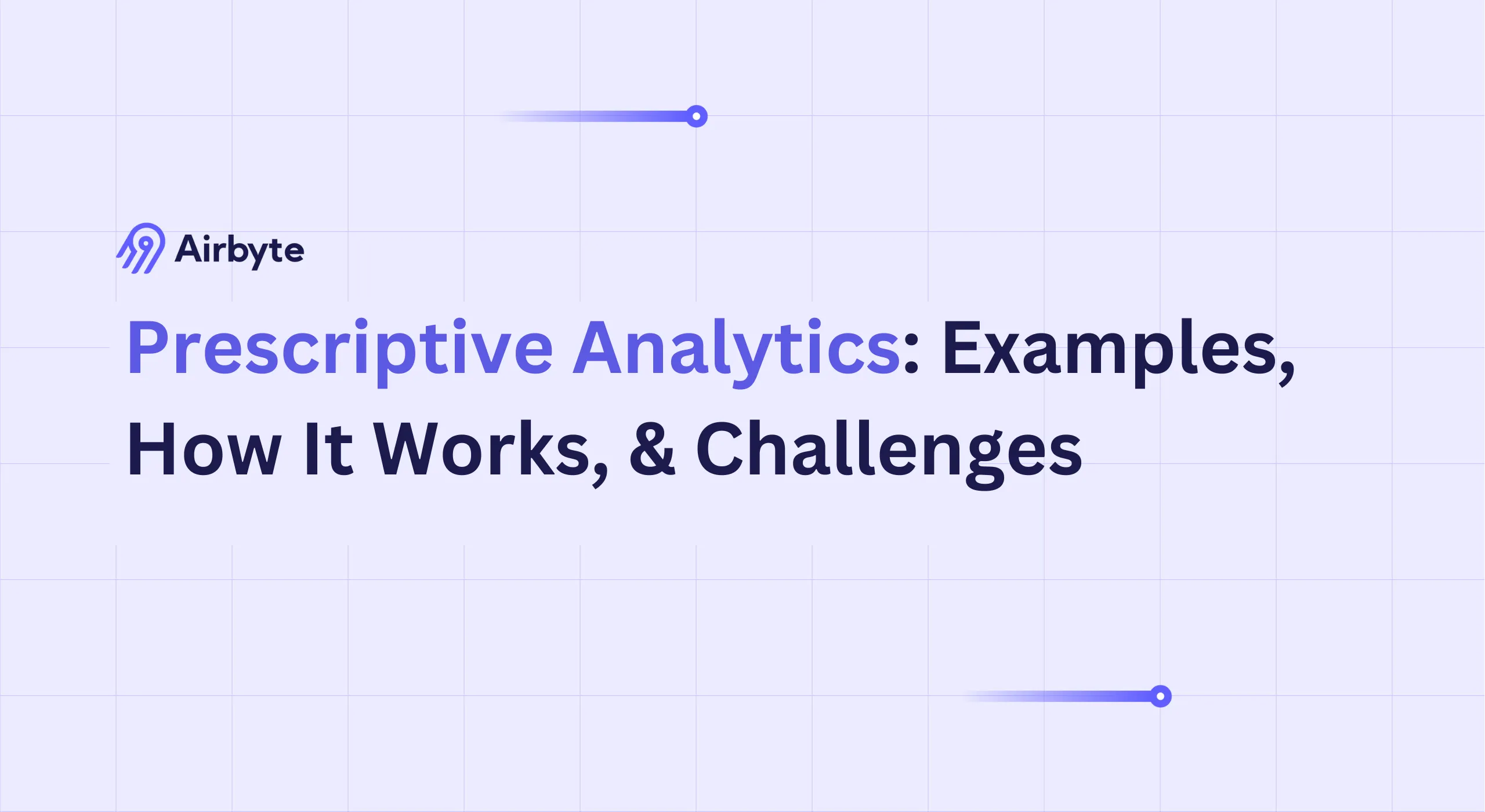Prescriptive Analytics: Examples, How It Works, & Challenges
Summarize this article with:
✨ AI Generated Summary
Prescriptive analytics advances beyond predictive analytics by recommending optimal actions based on data-driven insights, integrating machine learning, optimization, and causal inference to drive measurable business outcomes. Key benefits include optimized decision-making, real-time adaptability, risk mitigation, and improved operational efficiency, while challenges involve data quality, integration complexity, ethical concerns, and governance.
- Combines descriptive, diagnostic, and predictive analytics with heuristics and reinforcement learning for actionable recommendations.
- Incorporates causal inference frameworks to ensure reliable cause-effect understanding and intervention validation.
- Employs ethical AI, explainability, and human-algorithm governance models for transparency, bias mitigation, and accountability.
- Utilizes advanced technologies like quantum-hybrid optimization and multi-objective reinforcement learning for complex, dynamic decision-making.
- Requires robust data integration, continuous monitoring, and multi-stakeholder governance to maintain compliance and effectiveness.
Prescriptive analytics moves beyond predictions to deliver actionable recommendations that drive measurable results, transforming unreliable data insights into strategic advantage.
Unlike descriptive analytics, which focuses on past events, or predictive analytics, which forecasts future outcomes, prescriptive analytics goes a step further by suggesting the best course of action to achieve specific business goals.
What Are Prescriptive Analytics and How Do They Work?
Prescriptive analytics is an advanced type of data analytics that helps you determine what actions to take next to reach your desired outcome. This approach considers possible scenarios, available resources, past performance, and current performance to recommend the optimal course of action.
Because prescriptive analytics can inform decisions on any time frame—from immediate to long-term—it is especially useful in dynamic environments such as health care, supply-chain management, and financial planning, where timely and effective decision-making is critical. Modern prescriptive systems now operate through continuous learning mechanisms that automatically adapt to changing conditions, ensuring recommendations remain relevant and effective in fluid operational contexts.
What Are the Different Types of Data Analytics?
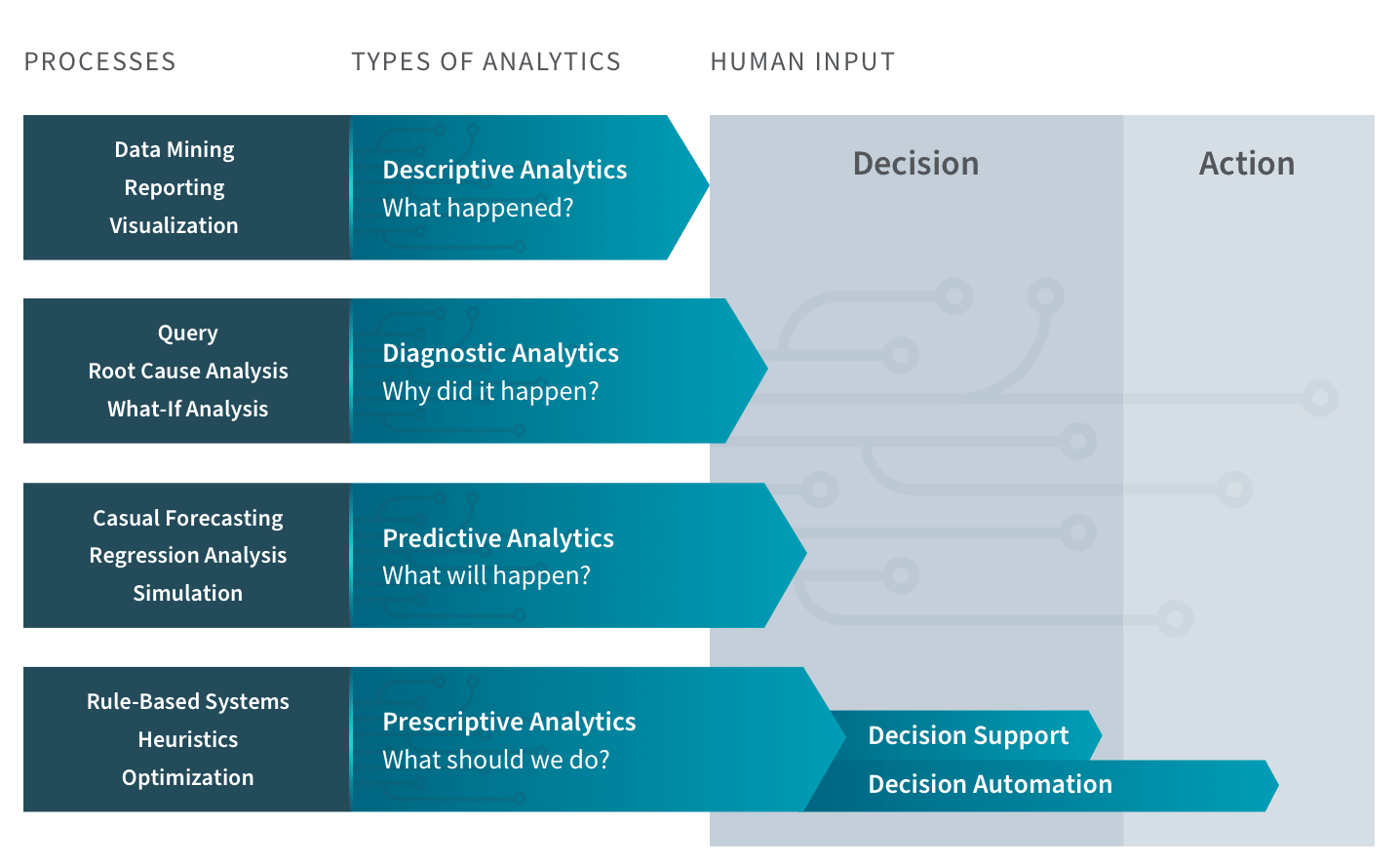
Descriptive
The simplest type of analytics. Descriptive analytics summarizes historical data to reveal what has happened. Techniques such as clustering, association-rule mining, or classification uncover patterns, which are typically presented with statistics and visualizations.
Diagnostic
Diagnostic analytics digs into historical data to explain why something happened. Using SQL queries, root-cause analysis, and what-if analysis, you can identify the factors or conditions that led to specific outcomes.
Predictive
Predictive analytics examines past trends to estimate what is likely to happen—for example, sales forecasts or customer-behavior predictions. Methods include regression analysis, simulation, and machine-learning algorithms.
Prescriptive
Prescriptive analytics combines the insights of descriptive, diagnostic, and predictive analytics, and layers on heuristics, machine learning, and rule-based systems to recommend what should be done next.
What Are the Key Benefits of Using Prescriptive Analytics?
Optimized Decision-Making
By analyzing historical data, real-time inputs, and predictive models, prescriptive analytics suggests the most effective actions, improving outcomes across complex operational environments. Advanced systems now incorporate multi-objective optimization that balances competing goals simultaneously, such as minimizing costs while maximizing customer satisfaction and maintaining quality standards.
Improved Operational Efficiency
It identifies inefficiencies, bottlenecks, and areas for improvement, enabling cost reduction and streamlined processes. Modern prescriptive systems can reduce operational costs through automated optimization recommendations that continuously adapt to changing conditions and constraints.
Risk Mitigation
Prescriptive models surface potential risks and recommend proactive measures, safeguarding operations and data assets. These systems continuously monitor environmental changes and adjust recommendations accordingly, incorporating uncertainty-handling mechanisms that maintain decision quality even when facing incomplete or noisy data.
Real-Time Adaptability
Advanced prescriptive analytics platforms now operate in real time, processing streaming data to provide immediate recommendations. This capability enables organizations to respond to market changes and operational disruptions within minutes rather than hours.
What Are the Main Challenges with Prescriptive Analytics?
Difficult-to-Define Fitness Functions
Optimizing a solution requires an accurate fitness (objective) function, which depends on deep business understanding. Organizations must clearly define success metrics and business constraints before implementing prescriptive systems. Modern frameworks address this challenge through multi-objective optimization techniques that allow stakeholders to express preferences dynamically rather than requiring perfect upfront specification. Multi-objective reinforcement learning systems now balance competing objectives through vector-valued reward functions, enabling real-time adjustment of recommendation strategies by encoding user preferences as weight vectors that modulate policy behavior during operation.
Human Bias and Ethical Considerations
Bias can enter through model design, data collection, or interpretation, compromising recommendations. Modern solutions incorporate ethical AI frameworks and bias-detection algorithms to minimize these risks. Explainable AI techniques now provide transparency into decision-making processes, enabling stakeholders to understand and validate recommendations before implementation. Contemporary prescriptive systems implement responsible AI integration through continuous auditing against constitutional AI principles, differential privacy mechanisms in sensitive domains, and automated bias amplification detection that freezes recommendations showing discriminatory patterns.
Data-Quality Issues
Incomplete or inconsistent data leads to misleading insights; high-quality data is essential. Organizations must establish robust data-validation processes and maintain comprehensive data-governance frameworks. Contemporary prescriptive systems include automated data-quality monitoring that flags inconsistencies and adjusts recommendations based on data-reliability scores. Advanced implementations incorporate blockchain-verified data lineage, bias detection during dataset construction, and regulatory-compliant anonymization to ensure prescription reliability and ethical compliance.
Integration Complexity
Prescriptive analytics requires seamless integration with existing operational systems to execute recommendations automatically. This integration challenge increases implementation complexity and requires specialized technical expertise. Modern platforms address this through standardized APIs and pre-built connectors that simplify integration with common enterprise systems. Organizations now adopt unified context fabric architectures that integrate transactional systems, IoT streams, and external datasets through real-time data products, enabling prescriptive models to operate on enriched contextual information while maintaining operational integrity.
How Do Causal Inference Frameworks Enhance Prescriptive Analytics?
Traditional prescriptive models often rely on correlational relationships that can generate spurious recommendations when deployed in complex business environments. Causal inference frameworks address this fundamental limitation by distinguishing genuine cause-effect mechanisms from coincidental patterns, ensuring prescriptive actions produce intended outcomes rather than unintended consequences.
Structural Causal Models for Business Applications
Structural causal models provide mathematical formalism to represent business processes through directed acyclic graphs that encode domain knowledge about confounding variables and intervention effects. These models enable prescriptive systems to quantify counterfactual scenarios using do-calculus frameworks, validating interventions through backdoor criterion adjustments before implementation.
Experimental Validation and Feedback Integration
Modern prescriptive systems integrate randomized control trial frameworks within analytics pipelines to establish A/B testing mechanisms that measure prescription efficacy continuously. These experimental protocols create feedback loops that update causal priors while detecting hidden interactions in multi-parameter systems.
Implementation Through Causal Discovery
Organizations can implement causal frameworks through automated causal discovery algorithms that learn structural relationships from observational data, reducing the knowledge engineering bottlenecks traditionally associated with expert-driven causal graph construction. These systems incorporate uncertainty quantification for causal relationships, enabling prescriptive recommendations that acknowledge causal model limitations while maintaining decision quality under incomplete causal knowledge.
What Are Human-Algorithm Governance Models for Prescriptive Analytics?
As prescriptive systems increasingly automate high-stakes decisions across healthcare, finance, and operations, establishing appropriate governance frameworks becomes critical for maintaining accountability, transparency, and ethical compliance. Human-algorithm governance models define the roles, responsibilities, and interaction patterns between automated systems and human oversight.
Dynamic Responsibility Allocation Frameworks
Dynamic responsibility allocation creates context-sensitive decision thresholds that automatically route decisions between automated systems and human oversight based on criticality scoring, uncertainty levels, and potential impact assessments. These frameworks implement uncertainty-triggered delegation protocols that revert control to human operators when confidence scores drop below predetermined thresholds or when bias amplification detection systems identify potentially discriminatory patterns.
Ethical Validation and Audit Systems
Modern governance frameworks embed continuous ethical monitoring layers that audit prescriptive recommendations against constitutional AI principles in real time. These systems implement differential privacy mechanisms for sensitive domains like healthcare while generating comprehensive audit trails that map decisions to specific ethical guidelines and regulatory requirements.
Multi-Stakeholder Governance Architectures
Effective governance requires coordination across data science teams, business stakeholders, legal compliance, and end users through structured governance architectures that define decision rights and escalation protocols. These frameworks establish cross-functional data contracts that clarify ownership, accountability, and performance expectations while creating feedback mechanisms that enable continuous improvement of both algorithmic performance and governance effectiveness.
How Does Prescriptive Analytics Compare to Predictive Analytics?
Modern prescriptive analytics has evolved beyond traditional optimization approaches to incorporate causal reasoning, real-time processing, and ethical governance frameworks. While predictive analytics identifies what might happen based on historical patterns, prescriptive systems understand why events occur and how interventions will affect outcomes, enabling more robust and reliable automated decision-making.
How Does Prescriptive Analytics Work in Practice?
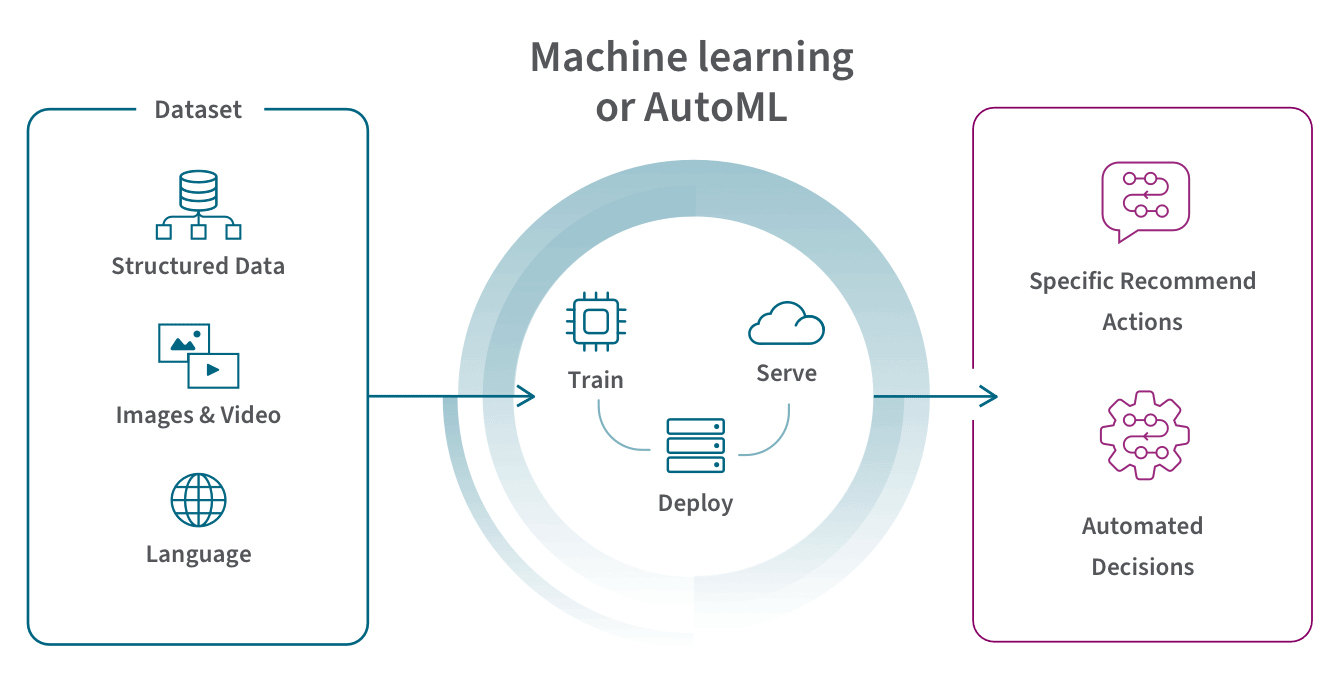
1. Define the Question
Formulating a clear question guides data requirements and ensures the insights will be actionable. Modern implementations incorporate influence diagrams that visually formalize prescription dependencies, mapping decision nodes, uncertainties, and objectives to enforce structural clarity and reduce model misspecification risks.
2. Integrate and Process Your Data
Gather historical data, real-time streams, and external factors in a centralized store, then process it for analysis. Contemporary approaches implement unified context fabric architectures that enrich data with contextual information through knowledge graphs and real-time data products, enabling more sophisticated causal reasoning and constraint handling.
Tools such as Airbyte simplify this step with 600+ pre-built connectors and advanced features like AI-assisted connector building, automatic detection of dropped records, and change-data capture (CDC). Modern data integration platforms like Airbyte now provide enterprise-grade security and governance capabilities across cloud, hybrid, and on-premises deployments, supporting the data sovereignty requirements essential for prescriptive analytics in regulated industries.
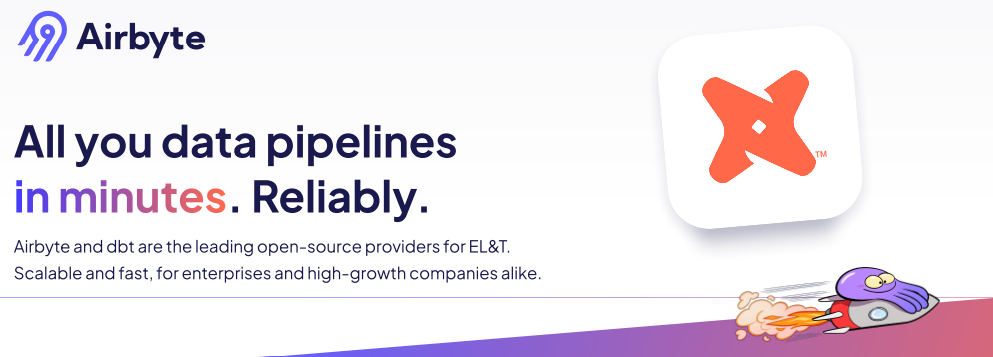
3. Develop and Deploy Your Model
Train ML-based or rule-based models on the integrated data, validate performance, and deploy to production, ensuring they adapt as new data arrives. Advanced implementations follow the CRISP-ML(Q) framework with iterative quality assurance, incorporating causal validation protocols and ethical auditing mechanisms to ensure prescriptive recommendations maintain effectiveness and compliance over time.
4. Take Action
Review or automate decisions based on model recommendations, ensuring alignment with business goals. Modern prescriptive systems implement dynamic responsibility allocation frameworks that automatically route decisions between automated execution and human oversight based on risk assessment, uncertainty quantification, and ethical considerations.
What Are Quantum-Hybrid Optimization Systems in Prescriptive Analytics?
Quantum-hybrid optimization combines classical computing with quantum processing to solve complex optimization problems that traditional systems cannot handle efficiently. These systems represent a frontier advancement in prescriptive analytics, enabling solutions to previously intractable combinatorial problems that appear in supply chain optimization, financial portfolio management, and manufacturing scheduling.
Theoretical Foundations
These systems convert optimization problems into Quadratic Unconstrained Binary Optimization (QUBO) formulations, allowing quantum processors to evaluate exponentially more solutions than classical computers. Quantum annealing handles combinatorial prescriptions in domains like genome sequencing that prove intractable for classical optimization approaches, while hybrid classical-quantum architectures leverage the strengths of both computing paradigms.
Practical Applications
- Supply Chain Optimization – Quantum-hybrid systems solve facility location and routing problems with thousands of variables, optimizing global logistics networks with unprecedented precision and speed.
- Financial Portfolio Management – These systems handle large-scale asset allocation problems, considering complex risk correlations and regulatory constraints that overwhelm traditional optimization approaches.
- Manufacturing Process Optimization – Quantum-enhanced scheduling systems optimize production sequences across multiple facilities while considering resource constraints, quality requirements, and delivery commitments.
How Do Multi-Objective Reinforcement Learning Systems Transform Prescriptive Analytics?
Multi-Objective Reinforcement Learning (MORL) balances competing objectives and adapts to dynamic human preferences through vector-valued reward functions. These systems represent a significant advancement over traditional single-objective optimization by enabling prescriptive analytics to navigate complex trade-offs between multiple business goals simultaneously.
Preference-Driven Adaptive Systems
MORL systems enable real-time adjustment of recommendation strategies by encoding user preferences as weight vectors that modulate policy behavior during operation. These frameworks incorporate Pareto frontier analysis to identify optimal trade-offs between competing objectives such as cost minimization, quality maximization, and customer satisfaction enhancement, enabling stakeholder-driven preference updates without requiring complete model retraining.
Meta-Learning and Adaptive Capabilities
Advanced MORL implementations incorporate meta-learning techniques that enable rapid adaptation to new contexts and changing business requirements. These systems train prescription models on heterogeneous datasets, enabling quick deployment across different operational domains while maintaining performance guarantees through automated model selection and hyperparameter optimization protocols.
What Role Do Causal Foundations and Ethical Frameworks Play in Modern Prescriptive Analytics?
The emergence of causal prescriptive analytics moves beyond predictive pattern recognition to model intervention effects within complex systems. This evolution addresses fundamental limitations in traditional prescriptive approaches that rely primarily on correlational relationships, potentially leading to ineffective or counterproductive recommendations when deployed in dynamic business environments.
Responsible AI Integration
Explainable AI techniques like SHAP and LIME enable transparent interpretation of prescriptive recommendations, addressing the black-box problem that historically limited adoption in regulated industries. These frameworks provide stakeholders with clear understanding of decision rationale while enabling validation of recommendation logic before implementation, significantly improving trust and adoption rates across healthcare, financial services, and public sector applications.
Enterprise Implementation Frameworks
The DEMATEL-ISM framework provides a methodology for mapping causal relationships between business variables through expert judgment and historical data analysis. This approach enables organizations to construct domain-specific causal models that inform prescriptive systems about intervention effects, confounding variables, and structural constraints that pure predictive approaches might miss, resulting in more reliable and effective prescriptive recommendations.
Continuous Ethical Monitoring
Modern prescriptive systems embed continuous monitoring capabilities that audit recommendations against ethical guidelines, detect algorithmic bias in real time, and ensure compliance with evolving regulatory requirements. These systems implement differential privacy mechanisms for sensitive data while maintaining audit trails that enable regulatory compliance and performance validation across diverse operational contexts.
What Are the Types of Prescriptive Analytics Models?
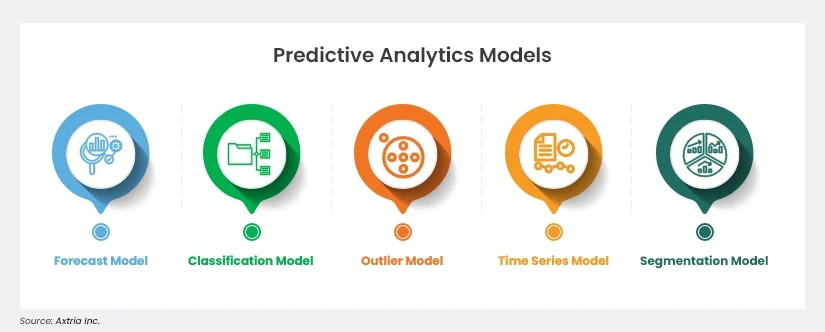
Forecast Model
Predicts future trends from historical data while incorporating real-time inputs to adjust recommendations dynamically. Modern implementations integrate streaming data processing capabilities that enable continuous forecast refinement based on emerging patterns, market conditions, and external factors, ensuring prescriptive recommendations remain current and actionable in volatile business environments.
Classification Model
Assigns items to predefined categories and prescribes appropriate actions for each classification. Advanced systems incorporate hierarchical classification schemes that enable nuanced decision-making across multiple categorical dimensions while maintaining interpretability and auditability requirements for regulated applications.
Outlier Model
Highlights anomalous data points and prescribes immediate response actions. Contemporary outlier detection systems incorporate causal reasoning to distinguish genuine anomalies requiring intervention from benign variations in normal operations, reducing false-positive alerts while ensuring critical issues receive appropriate attention and response protocols.
Time-Series Model
Analyzes sequential data to forecast future values and prescribe timing-sensitive actions. Modern implementations incorporate seasonal decomposition, trend analysis, and external factor integration to provide robust temporal predictions that inform strategic planning, resource allocation, and operational scheduling decisions across multiple time horizons.
Segmentation Model
Groups similar data points and prescribes tailored strategies for each segment. Advanced segmentation approaches incorporate dynamic clustering algorithms that adapt to changing customer behaviors, market conditions, and business requirements while maintaining segment stability sufficient for strategic planning and resource allocation purposes.
Reinforcement Learning Models
Learn optimal actions through trial-and-error interactions with the environment. Modern reinforcement learning implementations incorporate safety constraints, multi-objective optimization, and human-in-the-loop validation to ensure learning processes align with business objectives and ethical requirements while maintaining operational safety and performance standards.
Conclusion
Prescriptive analytics represents the most advanced form of data analytics, moving beyond prediction to provide actionable recommendations that drive measurable business outcomes. By combining machine learning, optimization algorithms, and causal inference frameworks, organizations can transform data insights into strategic advantages across healthcare, retail, financial services, and manufacturing. Modern implementations featuring multi-objective optimization, quantum-hybrid approaches, and ethical governance frameworks ensure prescriptive analytics delivers reliable guidance while maintaining compliance with evolving regulatory requirements.
Frequently Asked Questions
1. What is prescriptive analytics, and how does it differ from predictive analytics?
Prescriptive analytics extends predictive analytics by recommending optimal actions based on predicted outcomes. While predictive analytics answers “What might happen?”, prescriptive analytics answers “What should we do?” using optimization, machine learning, and real-time data for actionable decision-making.
2. What are the key benefits of using prescriptive analytics in business operations?
Prescriptive analytics enhances efficiency, reduces costs, and improves decision-making by recommending optimal actions. It enables real-time responses, risk mitigation, and adaptive learning. Businesses gain measurable ROI through optimized operations in areas like supply chain management, finance, healthcare, and customer experience.
3. What challenges do organizations face when implementing prescriptive analytics?
Key challenges in prescriptive analytics include poor data quality, integration complexity, unclear objectives, and bias in decision models. Organizations also struggle with transparency, ethical concerns, and balancing automation with human judgment in high-impact decision-making environments
4. How does causal inference enhance prescriptive analytics?
Causal inference improves prescriptive analytics by identifying true cause-and-effect relationships, ensuring recommendations produce intended outcomes. Using methods like Structural Causal Models and causal discovery, it validates interventions, reduces bias, and enables reliable, data-driven decisions.
5. What governance frameworks ensure the responsible use of prescriptive analytics?
Governance frameworks for prescriptive analytics include human-algorithm oversight, multi-stakeholder governance, ethical audits, real-time bias detection, regulatory audit trails, and differential privacy, ensuring transparency, fairness, compliance, and accountable, trustworthy decision-making.

.webp)
